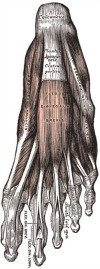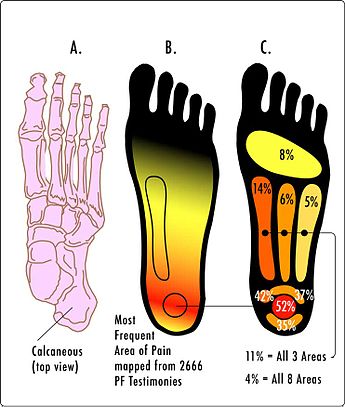Plantar Fasciitis Treatment

Just follow along with the videos below.
Go directly Plantar Fasciitis Treatment video with these links:
Intro,
Video 1,
Video 2,
Video 3 .
This short introductory video is a great place to start. It will give you a good overview of how to get the most out of this website and help you get the best possible results from the videos below.
Click directly to any pain relief video on this page:
Intro,
Video 1,
Video 2,
Video 3 .
*Please Watch This Short Video First. Thanks.
Please visit the techniques page now, if you haven't already.
On the homepage I describe…in detail…the 3 Simple Steps and the 4 Basic Facts about your body that make it possible for you to provide your own shin splint symptoms pain relief.
Detailed Instructions For
Plantar Fasciitis Treatment

Click directly to any pain relief video on this page:
Intro, Video 1, Video 2, Video 3 .
Step 1 in your plantar fasciitis treatment will target the bottom of your foot, not just where it hurts, but everywhere that is tight.
Here's what we're going to do:
A. Bottom of Foot Release -
The press-pull-release technique using both your thumbs on the bottom of your foot is a very effective way to release tight tissue.
Doing the press-hold-move technique is quite effective too. Just flex your toes up and down while pressing your thumbs into the tight tissue.
You can also do the same work on your foot by lying on your back and working on the bottom of your foot with your fingertips. Any combo of thehand-on-hand technique while you perform the press-pull-release technique or the press-hold-move technique can be very effective.
And you can try out tennis-ball-press technique pressing a tennis ball into the bottom of your foot while in a seated or standing position.
*For future reference, notice how much this specific plantar fasciitis treatment relieves your plantar fasciitis symptoms.
Click directly to any pain relief video on this page:
Intro,
Video 1,
Video 2,
Video 3 .
All the muscles that attach to your foot from above, below, in front and back, and on both sides need to be properly balanced with each other in order for your foot to work properly. But with plantar fasciitis symptoms your calf muscles can be a major causative factor. When your calf if tight it can pull on your heel bone, which then pulls on your plantar fascia.
First we'll release a muscle that makes your calf tight. Then we'll release your calf, which can make your plantar fascia tight.
Here's what we're going to do:
A. Front of Shin Release - Tibialis Anterior
My favorite hand-on-hand technique in conjunction with the press-hold-move technique. is my favorite for this very powerful muscle.
You can also add in some press-pull-release technique if you desire.
For future reference, notice how much this specific plantar fasciitis treatment relieves your plantar fasciitis symptoms.
B. Calf Stretch (do this stretch slowly) -
This is your basic calf stretch, BUT with two main differences.
First, make sure you "engage" (flex just a little bit) your calf muscle while you stretch it.
And second, it's important to do this stretch slowly and deliberately. No bouncing, no rush. Slow and steady as you go.
Lastly, my new Best Calf Stretches (click here) page is worth checking out for even deeper insights into how to stretch your calf.
*For future reference, notice how much this specific plantar fasciitis treatment relieves your plantar fasciitis symptoms.
Click directly to any pain relief video on this page:
Intro,
Video 1,
Video 2,
Video 3 .
Step 3 - Stop Nerve Pathway Irritation
Here's what we're going to do:
A. Reclined Hip Stretch
B. Seated Hip Stretch
C. Tennis Ball Hip Release
D. Hamstring Stretch
For all of the above stretches they are best learned by watching the videos and actually seeing me do them. You always want to feel these stretches in the bellies of the muscles you are trying to stretch. And you do NOT ever want to feel like you are torquing your joints as you do these stretches.
And most of all, take your time, learn how to do them properly and they will serve you well.
Self-Assessment Of
Plantar Fasciitis Treatment
Did Step 1, Step 2, or Step 3 work best?
Was there one specific technique that instantly relieved your ankle pain? Remember what worked best for you, so you can do that first next time you need it.
Are you still experiencing some plantar fasciitis symptoms?
Which muscles are still tender (that means they are too tight!) and could use some more work?
Go back and repeat those techniques that seem to need a few more rounds. You may be pleasantly surprised at the results you get now that you've released other muscles that may prevented them letting go on the first attempt.
Investigate a bit and you'll eventually find which specific plantar fasciitis treatment techniques work best for you to provide the most relief. Then you'll be able to fix yourself whenever you desire because you'll have your own personalized program……literally at your fingertips!
The entire Foot Pain Relief page (click here) can be added to your treatment if your plantar fasciitis symptoms still remain.
Return from this Plantar Fasciitis Treatment page to the
Do-It-Yourself Joint Pain Relief Homepage
This Free Pain Relief Website
By Clicking On Your Favorite Icon Below:
Add Gary Crowley to your Google Plus Circles -
Google+ (click here)
Copyright © 2011 - 2022 DiyJointPainRelief.com


